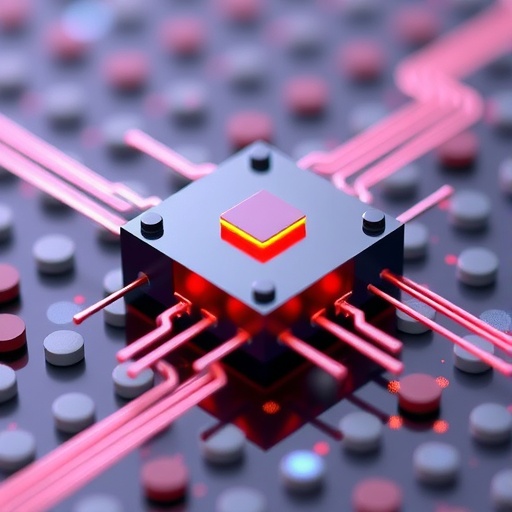A groundbreaking advancement in the field of nanotechnology has emerged from the engineering labs of the University of Michigan, unveiling a novel transistor-like device that elegant artfully tames the flow of quantum quasiparticles known as excitons at room temperature. This transformative switch could revolutionize the way information is processed and transmitted in our everyday electronics, potentially leading us to a future where circuits function primarily on quantum rather than electrical means.
Excitons, unique pairs of negatively charged electrons and their positively charged counterparts—known as “holes”—bring forth distinct advantages in the realm of data transfer and energy efficiency. Unlike their electrically charged brethren, excitons possess a neutral charge, allowing them to traverse materials with minimal wastage of energy. This property could significantly mitigate the heat generation issues we grapple with in conventional electronics, a critical factor as devices become increasingly power-hungry with the rise of complex applications such as artificial intelligence and machine learning.
Mack Kira, one of the co-corresponding authors of the newly published research, underscores the urgency of this innovation in light of AI’s swelling energy demands. Traditional silicon-based systems struggle under the load of heavy computational tasks, leading to considerable energy consumption and undesirable heat generation. However, the prospect of excitonic circuits offers a tantalizing glimpse into a more sustainable future, where information is relayed without the same overhead penalties associated with electron movement.
The shift toward an excitonic framework could not only enhance energy efficiency but also potentially speed up the pace of information transfer to unprecedented levels. This is particularly vital as our society’s need for rapid data communication escalates, especially in data centers integral to modern digital infrastructure. The implications of this technology could be far-reaching, paving the path for a new generation of devices capable of harmonizing light and matter far better than previously achieved.
The researchers meticulously designed their device by creating a unique “energy landscape” which facilitates the directed flow of excitons. This structure allows excitons to glide along edges in a controlled manner—akin to how electrons flow through wires. By placing electrodes on either side of this physical “ridge,” the device can effectively gate the flow of excitons. This innovative approach marks a significant leap forward in our ability to manipulate quantum particles, providing a tangible method for controlling exciton movement in real-world applications.
As Kira explains, when the electrodes are activated, they generate an energy barrier that halts the excitons. Conversely, when deactivated, the excitons can flow unimpeded. This on-off switching mechanism, previously unachieved in excitonic devices, opens the door to a spectrum of applications in optoelectronics, which seamlessly blend light with electronic systems. The experiment yielded impressive results, demonstrating a switching ratio exceeding 19 decibels—a clear validation of the device’s practical utility in high-speed applications.
Integral to their strategy is a method that harnesses light in conjunction with electronic gating, leading to the classification of the device as an “optoexcitonic” switch. In this setup, the researchers utilized light to create excitons while simultaneously propelling them along their designated path. The synergy between light and excitons not only enhances the efficiency but also the control over the data transmission process itself. Through this innovative interaction, excitons were successfully transported over a distance of up to 4 micrometers in less than half a nanosecond at room temperature—a crucial milestone for room-temperature applications.
Looking ahead, the research team is keen on scaling up their technology by linking numerous excitonic switches together. This ambitious goal hints at the potential for constructing expansive circuits entirely based on excitonic principles. Kira’s vision suggests that while the current development represents a significant leap, the technology could mature into a fully operational optoexcitonic circuit.
Such advancements hold promise not only for conventional consumer electronics but also for more complex systems, such as advanced supercomputers and AI applications. The burgeoning demand for rapid data communication in an increasingly digital world could find its answer in the seamless efficiency of excitonic circuits, transforming everything from smartphones to autonomous vehicles and beyond.
The compelling essence of the study, funded partly by the U.S. Army Research Office and the U.S. Air Force Office of Scientific Research, lies not just in the radical concept but in its palpable real-world applications. As industries align more closely with sustainable practices, excitons may dictate the future direction of data processing and communication, heralding a new era within the tech landscape.
In conclusion, the innovations emerging from the University of Michigan’s engineering department reflect the profound promise of excitonics in reshaping our technological future. Based on the principles of quantum physics, these new discoveries present an opportunity to address the pressing challenges of power consumption and efficiency in electronics today. With ongoing research and the potential for further enhancements, the dream of a more energy-efficient, quantum-based digital infrastructure becomes ever more attainable.
Subject of Research: Control of quantum quasiparticles (excitons) at room temperature using novel nanostructures.
Article Title: Novel Nanostructure Switches Quantum Particles for Enhanced Data Transfer.
News Publication Date: October 2023.
Web References: University of Michigan
References: Kira, M., Deotare, P., Jiang, Z. (October 2023). Nanoengineered optoexcitonic switch. ACS Nano. DOI: 10.1021/acsnano.5c05057.
Image Credits: University of Michigan.
Keywords
Electrons, Excitons, Quantum Computing, Optoelectronics, Nanotechnology, Energy Efficiency, Data Transmission, Semiconductors, Artificial Intelligence, Electrical Engineering, Photonics.




